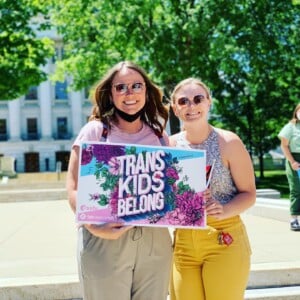As more and more students come out as transgender and nonbinary, they are seeking out spaces in school where they can feel safe and talk about their identities. Created by a former GSAFE youth leader, this resource gives some tips on how to make your GSA feel more welcoming and inclusive of trans students. Download it here.
 One of the most important things for GSAs to be is inclusive. Many facets of our culture lead us to do things which are hurtful and exclusive of some people without realizing it. With GSAs, many of the resources out there are unintentionally exclusive of transgender and nonbinary folks. Here are a few ways to make sure that your club is welcoming to people of all identities:
One of the most important things for GSAs to be is inclusive. Many facets of our culture lead us to do things which are hurtful and exclusive of some people without realizing it. With GSAs, many of the resources out there are unintentionally exclusive of transgender and nonbinary folks. Here are a few ways to make sure that your club is welcoming to people of all identities:
Gender-Inclusive Language
- Share Names and Pronouns at Every Meeting – This may seem repetitive and like a waste of time, but an easy way to make trans students feel comfortable is by asking for and using the right names and pronouns. And remember: transitioning is a process. Students may not know the name and set of pronouns that feel right immediately. Let them try out different options in the club to see which one feels the most right.
- Avoid Trans–Exclusive Phrases – Many commonly-used phrases subtly reinforce trans- exclusive ideas like the gender Examples of these are “ladies and gentlemen”, “he or she”, and so on. Try an activity with your GSA to identify some of these phrases that you commonly use. Make a list of trans-exclusive phrases and write down some alternatives next to each phrase. Some trans-inclusive alternatives to “ladies and gentlemen” are “friends”, “ladies and gentlemen, and those who identify as both or neither” or “everyone”, as well as some colloquial phrases such as “sisters, brothers, and others”. Use the pronouns “they/them/theirs” rather than “he/she” or “his/hers” when referring to someone whose pronouns are not known. And if you don’t know or remember someone’s pronouns, it’s okay to ask!
Activities
Make sure that your activities are trans-inclusive. These are some ways to be certain that the activities you do with your GSA are inclusive of all identities:
- Do Not Separate Into “Boys and Girls” – This is very commonly done in schools. Be sure to avoid this in the activities you do with your If your club is active in the school, and your school is a safe place to try and address such issues, you can advocate for an end to this practice throughout your school. A good place to start is in PE classes - this happens most frequently there.
- Create Activities Around Gender – These could involve watching movies, reading articles, or interactive activities. Do things as a club to educate club members more about gender-educating the GSA is the first step towards educating the whole school! Remember not to make it so that only trans people are responsible for educating the club; not all trans folks want to educate everyone they meet. It is also an ally’s responsibility to educate themselves in order to better educate others.
Activism
Be involved in making your school a more trans-inclusive place. There are many common issues in schools that your GSA can get involved in to make your school safer and more accepting for transgender and nonbinary youth.
- Gender–Neutral Bathrooms - One of the most important things your GSA can do for trans youth in your school is to ask the administration to establish gender-neutral Many trans youth feel that using traditional bathrooms is either dismissive of their identity or unsafe for them (or both). Based on the age and state of your building, the administration may be open to building new bathrooms. However, it is more likely that they will want to convert existing bathrooms into gender-neutral ones. It is a very good idea to have ideas of potential bathrooms that could be converted to gender-neutral bathrooms when you and members of your GSA approach your school’s administration.
- Nondiscrimination Policies – In Wisconsin, the statewide nondiscrimination and anti-bullying policies do not include discrimination and bullying based on gender identity or expression. However, there are many school districts that include gender identity and expression in their individual policies. If your district does not, think about starting an initiative to get these protections included. This will require meetings with the school board. GSAFE is happy to help if you would like to bring these protections to your district!
- Education – By far, the best way to change your school’s climate is by educating people throughout the school. A great way to do this is by asking teachers if you can come into their classrooms to teach about trans Be sure to educate your club first, then plan a workshop to present to various audiences. If your GSA is fairly new, you may want to build name recognition of the club before trying to go into classrooms.
- Names – Though many teachers are happy to use preferred names for students, this can become an issue when teachers are out and have substitutes instead. Talk to your administration about what they can do to allow students to have their preferred name show up on class rosters in order to avoid uncomfortable and potentially harmful situations with substitute teachers.
